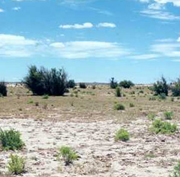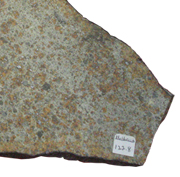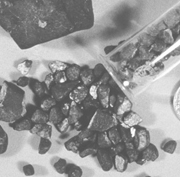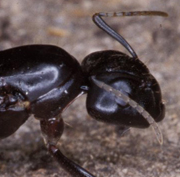Official Name:
Holbrook, the name of the small railway town where the shower fell.
Location:
13 kilometres east of Holbrook, Arizona, USA
Fall or Find:
Fall
Date:
19 July 1912, 7 :00 p.m., local time
Mass Recovered:
218 kilograms
Number of Fragments:
Over 16 000 fragments have been found to date-half of them no bigger than a pea. Holbrook has yielded the smallest fragments of any known shower-some measure only 2 millimetres in diameter and weigh as little as 0.01 gram.

Enlargement
Desert landscape near Holbrook. Meteorite hunters often come here. |
|

Enlargement
Slice of the Holbrook meteorite. Its fusion crust can easily be seen along the edge. |
|
Strewn field:
The strewn field was 4.8 by 0.8 kilometres. The distribution of the rocks was unusual-small and large fragments were intermixed.
Crater:
No noteworthy crater was created. The meteorites bounced off metal roofs in the railway yard, raising dust when they struck the desert's surface.
Circumstances:
Holbrook residents heard a series of explosions that lasted over a minute. No luminous phenomenon was observed because of scattered cloud cover, but a trail of smoke crossed the sky from east to west. A boy came out of his house, curious about the noise the meteorites were making as they pummelled down on the roofs. He quickly went back inside, shouting, "It's raining rocks out there!"
History:
The famous meteorite hunter Harvey H. Nininger visited the site 19 years after the fall. Using a magnet, he recovered hundreds of tiny meteorites. He was astonished to discover that the tiniest fragments had been gathered together into little piles-ants had used them to build their anthills!

Enlargement
A few tiny fragments from the Holbrook meteorite. |
|

Enlargement
Ants have gathered the smallest meteorite fragments to build their anthills. |
|
Type:
Stony meteorite
Class:
Ordinary chondrite
Group:
L6
Composition:
Holbrook is mainly composed of olivine and hypersthene. It has a low iron and sulphur content.
Scientific contribution:
Because the fragments were so small and there were so many of them, some people thought that the shower was caused by Earth passing through a meteoroid swarm, as is the case for shooting star showers. Studies proved that this was not the case-the rocks actually came from the fragmentation of a large object.
Scientists collected specimens of Holbrook in 1912, 1931, and 1968. This gave them the opportunity to study how stony meteorites deteriorate over time after their fall.
Comments:
Meteorite hunters continue to visit Holbrook's strewn field, hoping to add a fragment from this famous shower to their collection. Some hope that they might even discover a large meteorite buried in the desert sand since 1912.
Part of the Planétarium's collection:
Yes